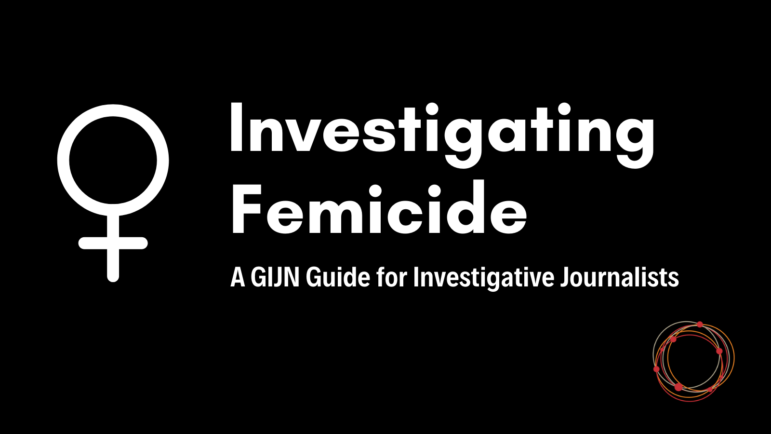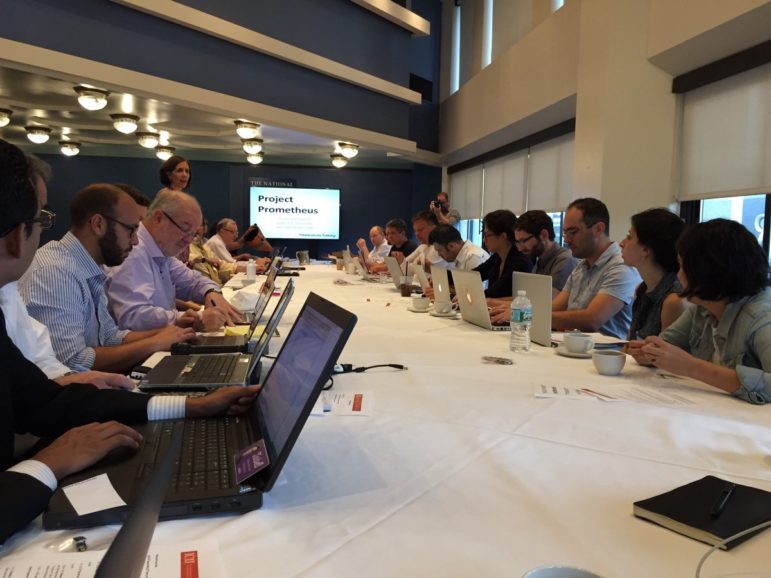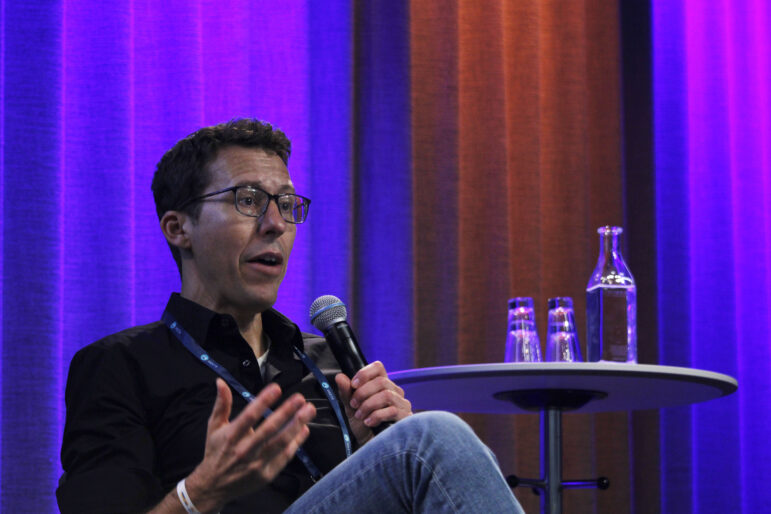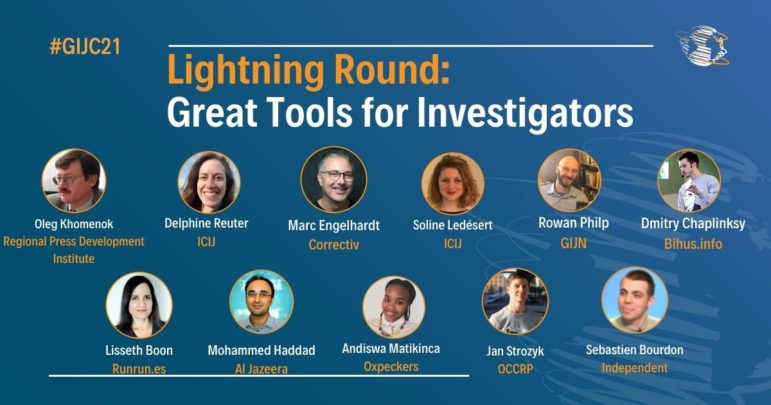

10 Tips for Successful Collaboration Among Journalists
Journalism collaborations across news organizations have reaped countless benefits in recent years, resulting in more accurate and impactful reports, offering protection for professionals in danger, and making possible stories which would have been impossible stories to do alone. Here is our best advice, crowdsourced from our collaboration with more than 500 journalists around the world.
1. Take the First Step
Don’t expect your collaborators to come to you. Don’t let a good story idea rot. If you have valuable information and potential for collaboration, identify partners and show them your best fruit. This should be fast and informal. This may seem obvious, but we find that reaching out is the hardest step for reporters like us, who usually operate as solitary detectives. But by doing this, you often help yourself: Bastian Obermayer and Frederik Obermaier, who broke the Panama Papers and the Paradise Papers, are one of the best examples.
2. Find Your Best Partners
Your best partner is not always a kick-ass journalist from a top-notch media outlet. It may be a young reporter from a small newsroom or a passionate freelancer. Younger journalists are sometimes better collaborators because they are often more ambitious, flexible and creative. As you do with sources, figure out your common interests. Check their background and credentials. Find someone whose skills are not necessarily like yours, but complementary, like ProPublica and The Texas Tribune.
3. Be Generous
Focus on the story rather than your immediate interests. Contribute to your partner’s work. Do it as if you were working for yourself. Usually, if you are generous, your partners will do their best to help when you need them.
Give credit to all the people that contributed to a story, no matter how they participated; it is important for everyone to be recognized. They’ll appreciate it, and it will help keep the team going through the finish line. Also, they will return the favor for you and pass it on to others.
4. Be Clear
Be clear about what you expect from your partner: the publication schedule (with time zones), the level of transparency among partners and who will have priority if you can’t publish at the same time. Put this in writing; it will be a useful reminder in the final rush and also make the commitment to your own colleagues and editors stronger. Be sure to update these terms as needed. It’s important to focus on just a few communication tools, or only one, to maintain clear understanding among partners. Be agile and avoid bureaucracy. Don’t have meetings without clear goals.
It is helpful to be as specific as possible in your communication. The more you can tell your collaborators about what you have looked at and discovered, the better they can do their part.
5. Honor Your Commitments
Be aware of your own limits. Remember it is fundamental to be clear about available resources, time and tools. There is always a good excuse for not holding your commitments, especially deadlines. But honoring what you promised is essential to build trust.
6. Embrace a Radical Sharing Attitude
This means you have no secrets from your collaborators. Don’t hide the golden nuggets you have found. Of course, everyone will find out you were hiding stuff when you publish it. Keeping information to yourself endangers the relationship you have built. Also, you may miss the chance to benefit from feedback, additional context or insights. If you can’t share something, explain the reasons.
Before publication, share drafts of your story with your partners, and be transparent in your process.
7. Be Aware of the Risks
Be upfront with your collaborators about potential dangers before they dive in. You’re dealing with information collected by several reporters, so be discreet and cautious with all documents and data. Be extra careful with the identities of your sources and the information they provide. Be sure that you can share.
Starting a collaboration with people you have never worked with is always an uncertain bet. Most of your partners won’t scoop you or endanger the story with bad practices. But some level of risk will always remain. Be aware of that. Tell it to your editors, but help them understand that the benefits of building a great story are worth the risks.
Some stories can only be told with collaborations. Find the best moment to inform your managers about the project. Make them feel part of it. Their decision to let you work on it should be recognized as fundamental. After the publication, share the success with them.
8. Recognize When It’s Not Possible
The media world isn’t Disneyland. There is a lot of competition, and sometimes your potential collaborator is a direct competitor. In other situations, the difference in the pace of production pace difference may be too big, such as between a TV documentary producer who needs weeks or months, and a daily journalist, who has a very short timeframe. If this is the case, accept it and don’t collaborate.
9. Be Flexible
Collaborators don’t necessarily publish the same story in their respective outlets. They can put out one story here and a different one there. The audience and the focus don’t need to be identical.
Flexibility is also vital. Different personalities, cultural backgrounds and experience levels are far more challenging to deal with than you imagine. Be patient.
There is often something you don’t expect. You may encounter a last-minute problem, or some awesome smoking gun may surface. Manage your project in an agile way and regularly reassess your goals. Don’t panic.
10. Be Confident
Your mindset will have a direct impact on your results. Collaboration is human interaction. If you’re skeptical from the beginning, the partnership will end badly. But, if you approach every challenge with positive thinking, if you share your commitment and passion for a topic, and if you show empathy and kindness, you’ll inspire your collaborators to do the same. In their turn, they will push you. This behavior will maintain everyone’s enthusiasm through a difficult, long term project.
Bonus (and obvious) advice: Almost everything above is also valid for collaborations within a newsroom or a larger media group.
The authors are investigative journalists from Brazil, China, Switzerland and Mexico. Together, they have collaborated with more than 500 colleagues in dozens of projects. Some were small projects with just two journalists, some much bigger such as Tobacco Underground, Operation Car Wash, and ICIJ projects from Offshore Leaks to Paradise Papers. They now work in a team at JSK Fellowships at Stanford University. JSK Impact Leader and group advisor Djordje Padejski contributed to this post, which first appeared on Medium and is cross-posted with permission.
 Guilherme Amado is an investigative reporter for Brazil’s O Globo daily newspaper. In 2014, he developed a WhatsApp-based network, Narcosur, to connect Latin American reporters on organized crime. In 2016, he was the only Brazilian member of a multinational team covering Car Wash, Brazil’s largest-ever corruption investigation.
Guilherme Amado is an investigative reporter for Brazil’s O Globo daily newspaper. In 2014, he developed a WhatsApp-based network, Narcosur, to connect Latin American reporters on organized crime. In 2016, he was the only Brazilian member of a multinational team covering Car Wash, Brazil’s largest-ever corruption investigation.
 Xin Feng was most recently a reporter with China Central Television’s English News Channel, where she specialized in in-depth reporting on public affairs and business. Earlier, she worked as a multimedia reporter for the English-language China Daily. She has won three national journalism awards.
Xin Feng was most recently a reporter with China Central Television’s English News Channel, where she specialized in in-depth reporting on public affairs and business. Earlier, she worked as a multimedia reporter for the English-language China Daily. She has won three national journalism awards.
 Titus Plattner is an investigative reporter. Previously, he worked for the investigative team of two Sunday newspapers in Switzerland, Le Matin Dimanche and SonntagsZeitung. Since 2013, he has participated in ICIJ’s OffshoreLeaks, ChinaLeaks, Luxleaks, Swissleaks and Panama Papers.
Titus Plattner is an investigative reporter. Previously, he worked for the investigative team of two Sunday newspapers in Switzerland, Le Matin Dimanche and SonntagsZeitung. Since 2013, he has participated in ICIJ’s OffshoreLeaks, ChinaLeaks, Luxleaks, Swissleaks and Panama Papers.
 Mago Torres is a Mexican researcher and educator. She is a cofounder of Periodistas de a Pie, a network of journalists in Mexico. She worked for ICIJ as a researcher the Panama Papers project, helped launch the GIJN Help Desk, and coordinated the journalism program at Universidad Iberoamericana in Mexico City.
Mago Torres is a Mexican researcher and educator. She is a cofounder of Periodistas de a Pie, a network of journalists in Mexico. She worked for ICIJ as a researcher the Panama Papers project, helped launch the GIJN Help Desk, and coordinated the journalism program at Universidad Iberoamericana in Mexico City.










